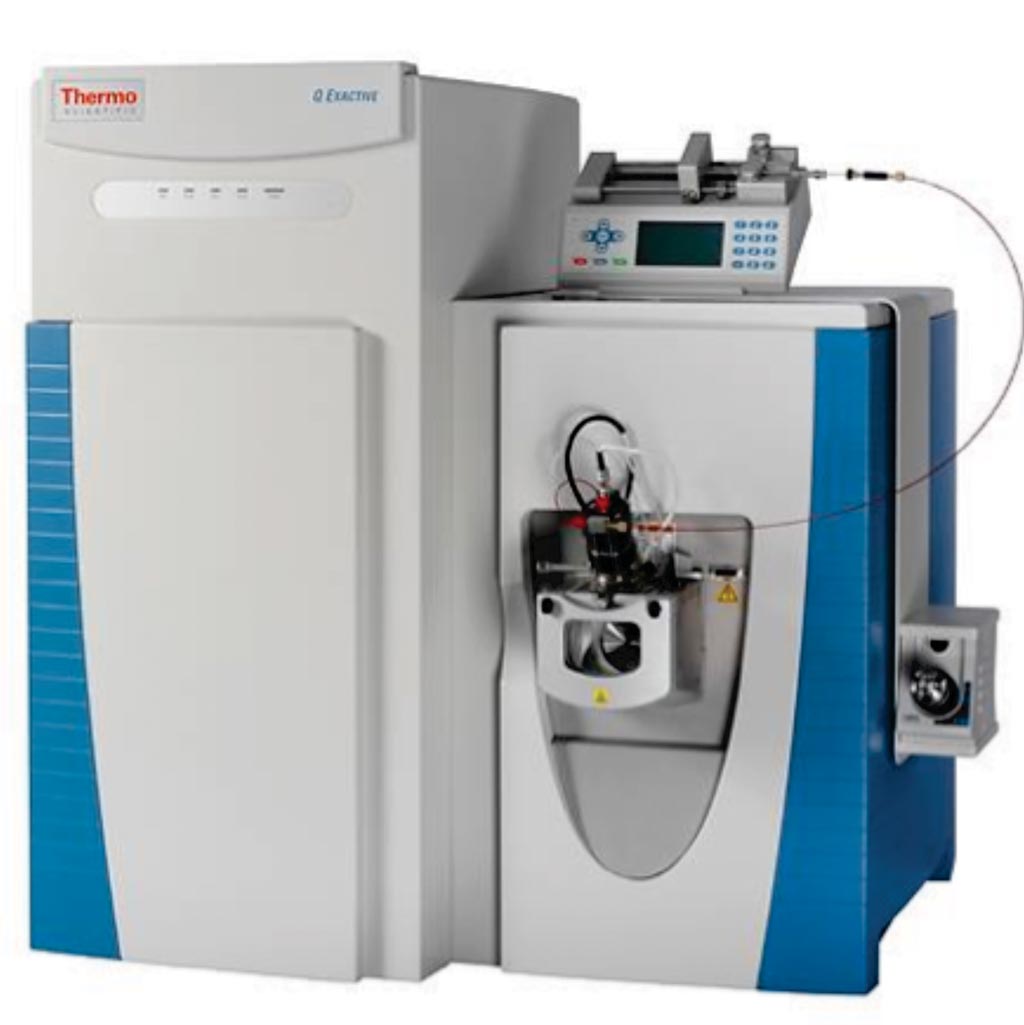Proteins Used for Diagnosing ALS
|
By LabMedica International staff writers Posted on 20 Nov 2018 |

Image: Q Exactive hybrid quadrupole-Orbitrap mass spectrometer (Photo courtesy of Thermo Fisher Scientific).
Proteins have been identified that may be useful in both earlier diagnosis of Amyotrophic Lateral Sclerosis (ALS) and in more accurate disease prognosis. ALS, often referred to as Lou Gehrig's disease, is a progressive, neurodegenerative disease that affects the brain and spinal cord. Currently, there is no effective treatment or cure.
No molecular biomarkers of neither diagnostic nor prognostic value exist for ALS. Diagnosis is often delayed one to two years from symptom onset while other confounding disorders are excluded and appropriate phenotypes present themselves. Since cerebrospinal fluid (CSF) is proximal to site of injury, it is more likely to be enriched with biomarkers of ALS compared to plasma and is often the fluid of choice for ALS and other diseases of the central nervous system.
Scientists from North Carolina State University (Raleigh, NC, USA) obtained samples of cerebrospinal fluid (CSF) and blood plasma from 33 ALS patients and 30 healthy individuals. The team used mass spectrometry and they identified over 1,000 different proteins in the fluids, and then used advanced machine learning techniques to develop models that consisted of multiple proteins. Nanoflow liquid chromatography tandem mass spectrometry (LC MS/MS) was performed and peptides were loaded directly on column at a flow rate of 400 nL/min. Peptides were separated at a flow rate of 300 nL/min using a 30 cm self-packed column. Data were collected using a top 12 data-dependent acquisition method on a quadrupole orbitrap.
The team selected two proteins that looked promising for both diagnostic and prognostic applications, and then conducted further analysis to validate their usefulness as biomarkers. The proteins, chitinase-3 like1 and alpha-1-antichymotrypsin, are associated with immune-system activation in the brain and thus could also be used as an objective way to measure effectiveness of current therapies directed at tempering this pathway. Proteins involved in complement activation, acute phase response and retinoid signaling pathways were significantly enriched in the CSF from ALS patients. Interestingly, immune-system activation is also known to play a role in other neurodegenerative diseases, such as Parkinson's and Alzheimer's, indicating the assays could potentially be used in these diseases as well.
Michael S. Bereman, PhD, an assistant professor and lead author of the study said, “Our goal is to create a panel of protein targets that could give doctors a quicker path to diagnosis for ALS patients, as well as an objective way to measure disease progression, or to test the efficacy of new drugs. Our next steps will be to look at changes in these proteins and their signaling pathways over time in fluids that have been longitudinally collected from ALS patients.” The study was published on November 5, 2018, in the journal Scientific Reports.
Related Links:
North Carolina State University
No molecular biomarkers of neither diagnostic nor prognostic value exist for ALS. Diagnosis is often delayed one to two years from symptom onset while other confounding disorders are excluded and appropriate phenotypes present themselves. Since cerebrospinal fluid (CSF) is proximal to site of injury, it is more likely to be enriched with biomarkers of ALS compared to plasma and is often the fluid of choice for ALS and other diseases of the central nervous system.
Scientists from North Carolina State University (Raleigh, NC, USA) obtained samples of cerebrospinal fluid (CSF) and blood plasma from 33 ALS patients and 30 healthy individuals. The team used mass spectrometry and they identified over 1,000 different proteins in the fluids, and then used advanced machine learning techniques to develop models that consisted of multiple proteins. Nanoflow liquid chromatography tandem mass spectrometry (LC MS/MS) was performed and peptides were loaded directly on column at a flow rate of 400 nL/min. Peptides were separated at a flow rate of 300 nL/min using a 30 cm self-packed column. Data were collected using a top 12 data-dependent acquisition method on a quadrupole orbitrap.
The team selected two proteins that looked promising for both diagnostic and prognostic applications, and then conducted further analysis to validate their usefulness as biomarkers. The proteins, chitinase-3 like1 and alpha-1-antichymotrypsin, are associated with immune-system activation in the brain and thus could also be used as an objective way to measure effectiveness of current therapies directed at tempering this pathway. Proteins involved in complement activation, acute phase response and retinoid signaling pathways were significantly enriched in the CSF from ALS patients. Interestingly, immune-system activation is also known to play a role in other neurodegenerative diseases, such as Parkinson's and Alzheimer's, indicating the assays could potentially be used in these diseases as well.
Michael S. Bereman, PhD, an assistant professor and lead author of the study said, “Our goal is to create a panel of protein targets that could give doctors a quicker path to diagnosis for ALS patients, as well as an objective way to measure disease progression, or to test the efficacy of new drugs. Our next steps will be to look at changes in these proteins and their signaling pathways over time in fluids that have been longitudinally collected from ALS patients.” The study was published on November 5, 2018, in the journal Scientific Reports.
Related Links:
North Carolina State University
Latest Clinical Chem. News
- Chemical Imaging Probe Could Track and Treat Prostate Cancer
- Mismatch Between Two Common Kidney Function Tests Indicates Serious Health Problems
- VOCs Show Promise for Early Multi-Cancer Detection
- Portable Raman Spectroscopy Offers Cost-Effective Kidney Disease Diagnosis at POC
- Gold Nanoparticles to Improve Accuracy of Ovarian Cancer Diagnosis
- Simultaneous Cell Isolation Technology Improves Cancer Diagnostic Accuracy
- Simple Non-Invasive Hair-Based Test Could Speed ALS Diagnosis
- Paper Strip Saliva Test Detects Elevated Uric Acid Levels Without Blood Draws
- Prostate Cancer Markers Based on Chemical Make-Up of Calcifications to Speed Up Detection
- Breath Test Could Help Detect Blood Cancers
- ML-Powered Gas Sensors to Detect Pathogens and AMR at POC
- Saliva-Based Cancer Detection Technology Eliminates Need for Complex Sample Preparation
- Skin Swabs Could Detect Parkinson’s Years Before Symptoms Appear
- New Clinical Chemistry Analyzer Designed to Meet Growing Demands of Modern Labs

- New Reference Measurement Procedure Standardizes Nucleic Acid Amplification Test Results
- Pen-Like Tool Quickly and Non-Invasively Detects Opioids from Skin
Channels
Molecular Diagnostics
view channel
Blood Test Enables Non-Invasive Endometriosis Detection
Endometriosis is a chronic, complex, yet relatively common gynecological disorder, reportedly affecting 1 in 10 adult and adolescent women. Endometriosis causes tissue similar to the lining of the uterus... Read more
New Blood Biomarkers Help Diagnose Pregnancy-Linked Liver Complication
Intrahepatic cholestasis of pregnancy (ICP) is the most common liver disorder linked to pregnancy and can pose serious risks for both mother and baby, including premature delivery and stillbirth.... Read moreHematology
view channel
MRD Tests Could Predict Survival in Leukemia Patients
Acute myeloid leukemia is an aggressive blood cancer that disrupts normal blood cell production and often relapses even after intensive treatment. Clinicians currently lack early, reliable markers to predict... Read more
Platelet Activity Blood Test in Middle Age Could Identify Early Alzheimer’s Risk
Early detection of Alzheimer’s disease remains one of the biggest unmet needs in neurology, particularly because the biological changes underlying the disorder begin decades before memory symptoms appear.... Read more
Microvesicles Measurement Could Detect Vascular Injury in Sickle Cell Disease Patients
Assessing disease severity in sickle cell disease (SCD) remains challenging, especially when trying to predict hemolysis, vascular injury, and risk of complications such as vaso-occlusive crises.... Read more
ADLM’s New Coagulation Testing Guidance to Improve Care for Patients on Blood Thinners
Direct oral anticoagulants (DOACs) are one of the most common types of blood thinners. Patients take them to prevent a host of complications that could arise from blood clotting, including stroke, deep... Read moreImmunology
view channel
Routine Blood Test Can Predict Who Benefits Most from CAR T-Cell Therapy
CAR T-cell therapy has transformed treatment for patients with relapsed or treatment-resistant non-Hodgkin lymphoma, but many patients eventually relapse despite an initial response. Clinicians currently... Read more
New Test Distinguishes Vaccine-Induced False Positives from Active HIV Infection
Since HIV was identified in 1983, more than 91 million people have contracted the virus, and over 44 million have died from related causes. Today, nearly 40 million individuals worldwide live with HIV-1,... Read more
Gene Signature Test Predicts Response to Key Breast Cancer Treatment
DK4/6 inhibitors paired with hormone therapy have become a cornerstone treatment for advanced HR+/HER2– breast cancer, slowing tumor growth by blocking key proteins that drive cell division.... Read more
Chip Captures Cancer Cells from Blood to Help Select Right Breast Cancer Treatment
Ductal carcinoma in situ (DCIS) accounts for about a quarter of all breast cancer cases and generally carries a good prognosis. This non-invasive form of the disease may or may not become life-threatening.... Read moreMicrobiology
view channel
Blood-Based Diagnostic Method Could Identify Pediatric LRTIs
Lower-respiratory tract infections (LRTIs) are a leading cause of illness and death worldwide, and pneumonia is the leading infectious cause of death in children under five, claiming the lives of over... Read more
Rapid Diagnostic Test Matches Gold Standard for Sepsis Detection
Sepsis kills 11 million people worldwide every year and generates massive healthcare costs. In the USA and Europe alone, sepsis accounts for USD 100 billion in annual hospitalization expenses.... Read moreRapid POC Tuberculosis Test Provides Results Within 15 Minutes
Tuberculosis remains one of the world’s deadliest infectious diseases, and reducing new cases depends on identifying individuals with latent infection before it progresses. Current diagnostic tools often... Read more
Rapid Assay Identifies Bloodstream Infection Pathogens Directly from Patient Samples
Bloodstream infections in sepsis progress quickly and demand rapid, precise diagnosis. Current blood-culture methods often take one to five days to identify the pathogen, leaving clinicians to treat blindly... Read morePathology
view channel
Rapid Low-Cost Tests Can Prevent Child Deaths from Contaminated Medicinal Syrups
Medicinal syrups contaminated with toxic chemicals have caused the deaths of hundreds of children worldwide, exposing a critical gap in how these products are tested before reaching patients.... Read more
Tumor Signals in Saliva and Blood Enable Non-Invasive Monitoring of Head and Neck Cancer
Head and neck cancers are among the most aggressive malignancies worldwide, with nearly 900,000 new cases diagnosed each year. Monitoring these cancers for recurrence or relapse typically relies on tissue... Read more
Common Health Issues Can Influence New Blood Tests for Alzheimer’s Disease
Blood-based tests for Alzheimer’s disease are transforming diagnosis by offering a simpler alternative to spinal taps and brain imaging. However, many people evaluated at memory clinics also live with... Read more
Blood Test Formula Identifies Chronic Liver Disease Patients with Higher Cancer Risk
Chronic liver disease affects millions worldwide and can progress silently to hepatocellular carcinoma (HCC), one of the deadliest cancers globally. While surveillance guidelines exist for patients with... Read moreTechnology
view channel
Artificial Intelligence Model Could Accelerate Rare Disease Diagnosis
Identifying which genetic variants actually cause disease remains one of the biggest challenges in genomic medicine. Each person carries tens of thousands of DNA changes, yet only a few meaningfully alter... Read more
AI Saliva Sensor Enables Early Detection of Head and Neck Cancer
Early detection of head and neck cancer remains difficult because the disease produces few or no symptoms in its earliest stages, and lesions often lie deep within the head or neck, where biopsy or endoscopy... Read moreIndustry
view channel
Abbott Acquires Cancer-Screening Company Exact Sciences
Abbott (Abbott Park, IL, USA) has entered into a definitive agreement to acquire Exact Sciences (Madison, WI, USA), enabling it to enter and lead in fast-growing cancer diagnostics segments.... Read more







 Analyzer.jpg)









